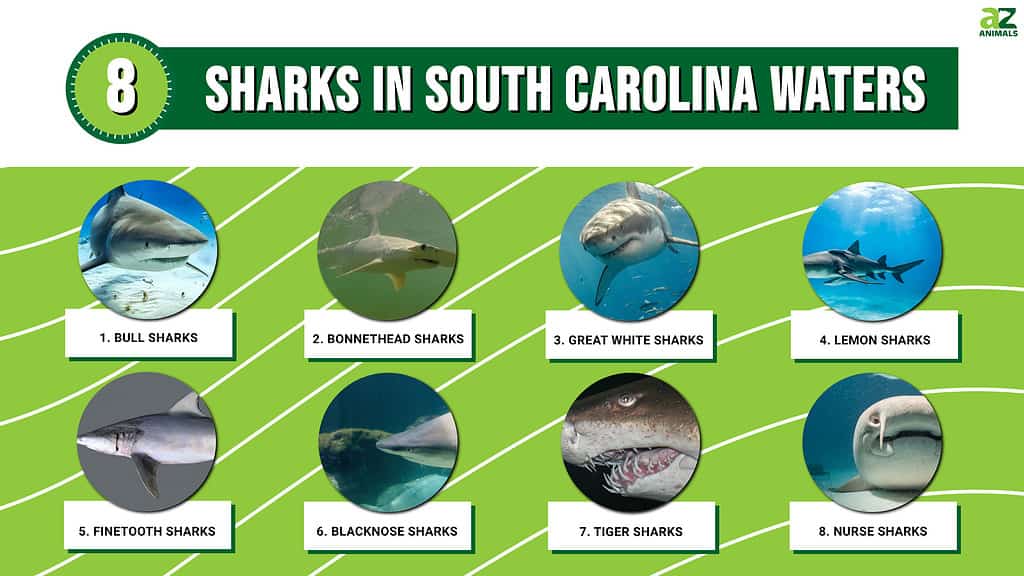
©
South Carolina is home to approximately 12 shark species, and it’s the fourth state in the United States with the most shark attacks – 111, to be precise. It’s preceded by California, with 132 attacks; Hawaii, with 182 attacks; and Florida, with 896 attacks;
Most of the attacks in South Carolina occurred in Charleston, Horry, and Beaufort counties, indicating that many sharks live in the area. However, South Carolina has many shark species that aren’t at all dangerous if not provoked, even if they are often seen near the beaches. For example, people sometimes swim near nurse sharks and never know that they’re there because they do not attack if they are not disturbed.
Let’s learn more about 8 sharks living in South Carolina waters!
1. Bull sharks

Bull sharks feed on fish, sea turtles, dolphins, rays, birds, and other smaller sharks.
©wildestanimal/Shutterstock.com
Bull sharks are the third-most aggressive species worldwide, as they rarely swim in waters deeper than 100 feet. The scientific name for bull sharks is Carcharhinus leucas. They live in warm coastal waters and feed on fish, sea turtles, dolphins, rays, birds, and other smaller sharks. They do not have natural predators, but there are records of crocodiles and other sharks killing some bull sharks. Bull sharks are large aquatic animals, growing to approximately 11 feet long.
According to shark attack records, bull sharks were seen in Burkes Beach, Folly Beach, and Debordieu Beach, but they’re common all around South Carolina.
2. Bonnethead sharks

Bonnethead sharks are the only omnivorous species of shark.
©IrinaK/Shutterstock.com
Bonnethead sharks are scientifically called Sphyrna tiburo and are the only omnivorous species of shark. This means they eat both plants and animals. They are the only sharks with a demilune-shaped head with eyes on either end of their heads.
Bonnethead sharks have one large dorsal fin, a smaller fin near the tail, an anal fin, a pair of pelvic fins, and a pair of pectoral fins. They have long tails and sharp teeth in the front. These sharks are small, growing approximately 20-30 inches long, while some females can reach 39 inches. Bonnethead sharks are among the most abundant in the South Carolina region during June and October.
3. Great white sharks

Great white sharks can have a length of up to 26 feet and weigh as much as 4,200-5,000 pounds.
©Alessandro De Maddalena/Shutterstock.com
Great whites are one of the largest sharks in the world. They can have a length of up to 26 feet and weigh as much as 4,200-5,000 pounds. It is the most aggressive shark worldwide, followed by tiger and bull sharks. Their unique characteristic is the number of teeth they can have throughout their lives – up to 300, to be precise, that are grouped into rows. They feed on seals, porpoises, sea lions, dolphins, and smaller whales.
White sharks live in temperate, coastal, and open ocean waters. In South Carolina, great white sharks were spotted and involved in attacks near Hilton Head, Pawleys Island, Albergotti Creek, and Ramshorn Creek.
4. Lemon sharks
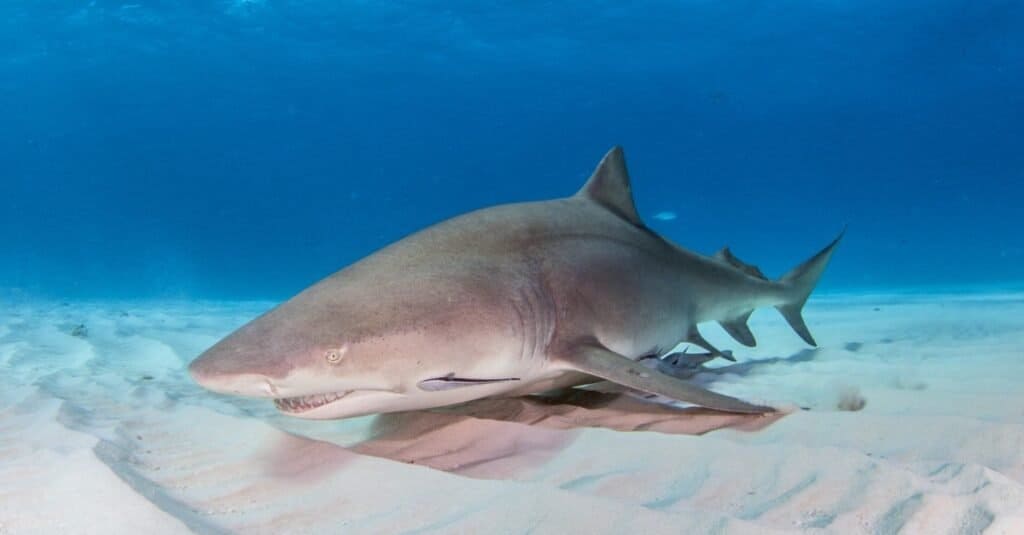
Lemon sharks are social aquatic animals that live in groups.
©Michael Bogner/Shutterstock.com
Lemon sharks are of yellow or brown coloration, hence their name. They are social aquatic animals that live in groups. They are rarely involved in shark attacks and are not considered dangerous to humans if not threatened. Another reason why they rarely attack humans is the fact that they tend to feed during the night. Their primary food source is fish.
Lemon sharks are usually 10–11 feet long and live in shallow coastal waters, near mangroves, coral reefs, or enclosed bays. Lemon sharks have two large dorsal fins, a pelvic fin, and a convex pectoral fin. They have flat heads and small eyes.
5. Finetooth sharks

Finetooth sharks reach a maximum length of 6.2 feet.
©Brenda Bowling, tpwd.texas.gov / public domain – License
Finetooth sharks are also called Carcharhinus isodon. They are requiem sharks that live in the western Atlantic, from South Carolina to Brazil. These aquatic creatures reach a maximum length of 6.2 feet. Their bodies are slender and streamlined, with a long, pointed snout and large, round eyes.
These sharks have 13–14 tooth rows on each side of the lower jaw and 12–15 on each side of the upper jaw. Finetooth sharks’ teeth are small and have the form of a needle. Their primary food source is small bony fish.
The finetooth shark is the second-most abundant shark species in South Carolina, where it arrives in late spring. It stays in South Carolina’s waters until early fall, living in estuaries and shallow coastal waters. During winter, finetooth sharks migrate to Florida.
6. Blacknose sharks
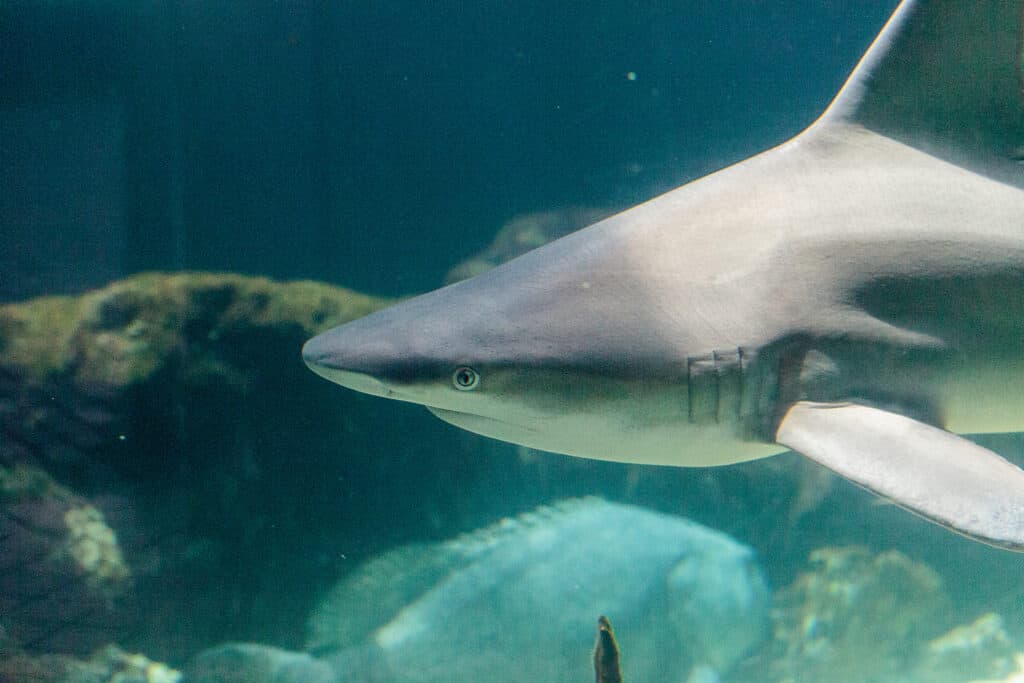
Juvenile blacknose sharks prefer shallow waters filled with coral and seagrass.
©iStock.com/LagunaticPhoto
Blacknose sharks are requiem sharks in the Carchahinidae family. These sharks are found from South Carolina to Brazil. Juvenile blacknose sharks prefer shallow waters filled with coral and seagrass, while adults choose deeper habitats. This species has large eyes, a long, rounded snout, and a small dorsal fin. They feed on cephalopods and bony fish. On average, these animals measure 4.2–4.6 feet long and weigh 22 pounds.
Even though they live near the shoreline, they rarely attack humans.
7. Tiger sharks
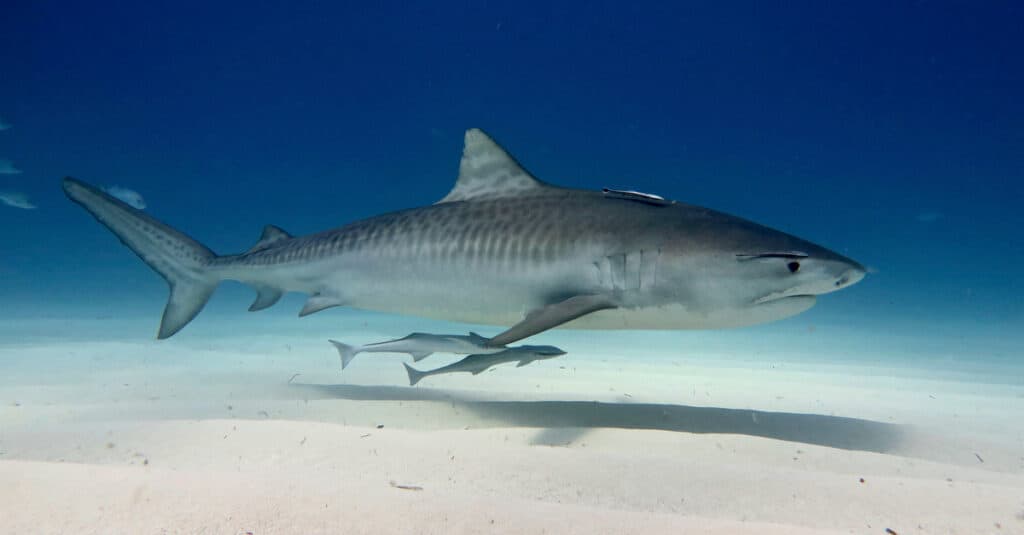
Tiger sharks are also known as “garbage fish” because they can feed on almost anything.
©HQuality/Shutterstock.com
Tiger sharks are also known as “garbage fish” because they can feed on almost anything! Their unique teeth help them eat all kinds of aquatic animals and plastic, empty cans, or other garbage in the ocean due to human actions. However, their favorite food sources are squid, rays, dolphins, seabirds, and sea turtles. These sharks grow to approximately 10–14 feet long.
They live in warm waters and are the second-most aggressive sharks in the world.
Regarding shark attack records, tiger sharks are common at Folly Beach and Charleston Harbor. At Folly Beach, for example, an 8–9-foot long tiger shark bit a 10-year-old girl while she was playing in knee-deep water.
8. Nurse sharks
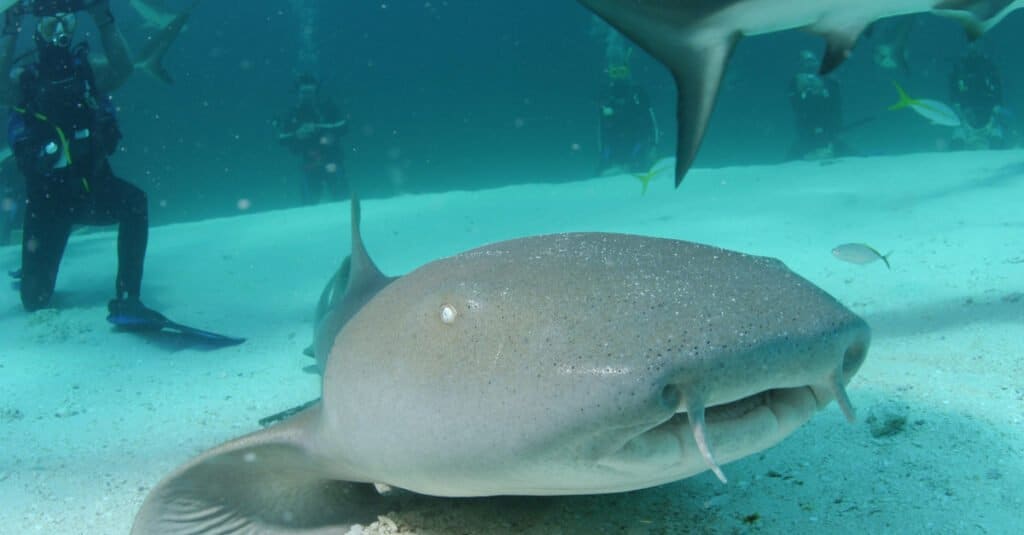
Nurse sharks grow to approximately 7.5–9 feet long and weigh around 150–300 pounds.
©tali de pablos/Shutterstock.com
Nurse sharks are known for their smooth skin, probably the smoothest among all shark species! These aquatic animals grow to approximately 7.5–9 feet long and weigh around 150–300 pounds. They have a broad body and a short snout. Their mouths are small and rectangular.
These sharks live in warm, shallow waters across the eastern part of the Pacific Ocean and the western part of the Atlantic Ocean, including South Carolina. They live near reefs, ledges, and wrecks. Nurse sharks are not aggressive and rarely attack humans. Most of the world’s attacks that involved nurse sharks were provoked.
The photo featured at the top of this post is © Yann hubert/Shutterstock.com
Thank you for reading! Have some feedback for us? Contact the AZ Animals editorial team.






